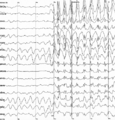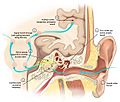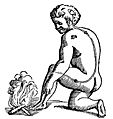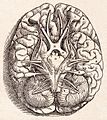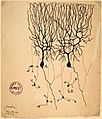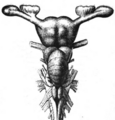Vertebrate brain facts for kids
The vertebrate brain is the main control center of the central nervous system. In animals with backbones, called vertebrates, the brain is located in the head. It is protected by the skull and is close to important senses like vision, hearing, balance, taste, and smell. As an animal moves, its senses gather information about its surroundings, and this information goes straight to the brain.
Brains are very complex. The brain controls other organs in the body. It does this by telling muscles to move or by releasing special chemicals called hormones and neurotransmitters. Muscle movements allow quick responses to changes around the animal. Hormones and the autonomic nervous system cause slower changes in the body. An adult human brain weighs about 1300 to 1400 grams.
The spinal cord can handle simple actions like reflexes or basic movements such as swimming or walking. But for more complex actions and behaviors, a central brain is needed.
All vertebrate brains have a similar basic structure. However, over evolution, brains have changed and become more effective. In simpler animals, most of the brain's structure is inherited. This means their behavior is mostly instinctive. In mammals, especially humans, the brain develops more through learning during life. This helps them adapt better to their environment. The ability to learn is best seen in the cerebral cortex.
Contents
How Does the Brain Work?
The brain and nervous system are mainly about making connections. They take in information from your sense organs and send out signals to your muscles.
- The brain is also connected to the endocrine system, which makes hormones. Hormones work slowly, so they cause gradual changes in the body.
- Think of the brain like a big department store. It has many different "departments" that do different things, but they are all connected. They work together to help you understand what your senses are telling you.
- Much of what your body does happens without you even thinking about it. For example, you breathe, your heart beats, your intestines digest food, and your hair grows. Some of these things, like breathing, you can control a little. But most of your body runs automatically, managed by the autonomic nervous system. The brain also does a lot of its work without you noticing. This is sometimes called the unconscious mind.
Main Parts of the Vertebrate Brain
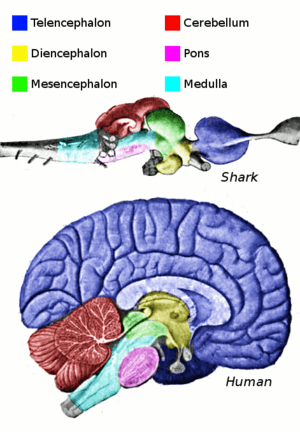
Several parts of the brain are found in all vertebrates, from hagfishes to humans. Here are some of the most important areas and what they do:
- The medulla (and the spinal cord) has many small areas that handle various automatic body functions. These include your heart beat, blood pressure, breathing, and even vomiting.
- The pons acts like a relay station. It carries messages between the cerebrum and the medulla and cerebellum.
- The hypothalamus is a small area at the base of the front part of the brain. It controls your sleep and wake cycles, eating and drinking, and the release of hormones. It sits right above the pituitary gland and sends hormones to it. The pituitary gland then makes hormones that affect the rest of your body.
- The thalamus is located above the hypothalamus. It collects all kinds of sensory information (except for smell) and sends it to the cerebral cortex. It also plays a role in consciousness and sleep.
- The cerebellum helps make your body's movements more precise. If the cerebellum is removed, an animal can still move, but its actions become shaky and clumsy. This precision is learned through practice, like when you learn to ride a bicycle.
- The tectum, often called the 'optic tectum', helps direct actions in space. Its main job is to control eye movements and reaching movements. It gets strong visual information and other sensory inputs that help direct actions.
- The hippocampus is found in mammals, but similar parts exist in all vertebrates. It helps with spatial memory (remembering places) and navigation in fish, birds, reptiles, and mammals.
- The basal ganglia are a group of structures in the front part of the brain. They are strongly connected to the cerebral cortex and the thalamus. Their main job seems to be choosing which actions to take. They send signals that stop other parts of the brain from acting. When the time is right, they release this stop signal, allowing actions to happen. Rewards and punishments greatly affect the basal ganglia.
- The cerebral cortex is a layer of grey cells on the surface of the front part of the brain. It is involved in many functions, including smell and spatial memory. In mammals, where it is very large, it controls many functions from other brain areas.
- The olfactory bulb is a special structure that processes smell signals. It sends these signals to the smell-related part of the cerebral cortex. It is a major brain part in many vertebrates but is much smaller in primates.
Brain Size and Body Size
Scientists have studied how brain size relates to body size in many different vertebrate species. Brain size usually increases with body size, but not always in the same way.
Mammals
In mammals, as the body gets bigger, the brain also gets bigger, but not at the same rate. This relationship is described by a special formula. However, each family of mammals is a bit different, showing how complex their behavior is. For example, primates (like monkeys and humans) have brains 5 to 10 times larger than the formula predicts. Animals that hunt other animals often have larger brains. When a mammal's brain grows, not all parts grow at the same speed. The larger a species' brain, the bigger the part taken up by the neocortex.
Images for kids
-
Neurons create electrical signals that travel along their axons. When a signal reaches a connection called a synapse, it releases a chemical called a neurotransmitter. This chemical then affects other cells.
-
Brain electrical activity recorded from a human patient during an epileptic seizure.
-
Diagram of signal processing in the auditory system.
-
Cross-section of a human head, showing location of the hypothalamus.
-
Illustration by René Descartes of how the brain creates a reflex response.
-
Andreas Vesalius' Fabrica, published in 1543, showing the base of the human brain, including optic chiasma, cerebellum, and olfactory bulbs.
-
Drawing by Santiago Ramón y Cajal of two types of neurons from the cerebellum of a pigeon.
-
Gulai otak, a beef brain curry from Indonesia.
-
The brain of a shark.




